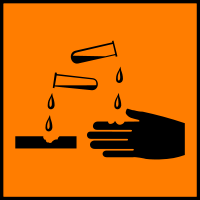|
Storage Condition
|
|
Room Temperature (15-30°C), Desiccate, Protect from light
|
 Show
data source Show
data source
|
|
|
Storage Warning
|
|
Harmful/Corrosive/Hygroscopic
|
 Show
data source Show
data source
|
|
Hygroscopic
|
 Show
data source Show
data source
|
|
|
RTECS
|
|
KM3850000
|
 Show
data source Show
data source
|
|
|
European Hazard Symbols
|
 Corrosive (C) Corrosive (C)
|
 Show
data source Show
data source
|
|
X
|
 Show
data source Show
data source
|
 Harmful (Xn) Harmful (Xn)
|
 Show
data source Show
data source
|
|
|
UN Number
|
|
1760
|
 Show
data source Show
data source
|
|
|
MSDS Link
|
|
|
German water hazard class
|
|
1
|
 Show
data source Show
data source
|
|
|
Hazard Class
|
|
8
|
 Show
data source Show
data source
|
|
|
Packing Group
|
|
II
|
 Show
data source Show
data source
|
|
|
Australian Hazchem
|
|
2X
|
 Show
data source Show
data source
|
|
|
Risk Statements
|
|
22-38-41-67
|
 Show
data source Show
data source
|
|
22-41-67
|
 Show
data source Show
data source
|
|
R:34
|
 Show
data source Show
data source
|
|
|
Safety Statements
|
|
26-36/37/39
|
 Show
data source Show
data source
|
|
26-39
|
 Show
data source Show
data source
|
|
S:26-27/28-36/37/39-46-64
|
 Show
data source Show
data source
|
|
|
EU Classification
|
|
C9
|
 Show
data source Show
data source
|
|
|
EU Hazard Identification Number
|
|
8B
|
 Show
data source Show
data source
|
|
|
Emergency Response Guidebook(ERG) Number
|
|
154
|
 Show
data source Show
data source
|
|
|
TSCA Listed
|
|
是
|
 Show
data source Show
data source
|
|
|
GHS Pictograms
|

|
 Show
data source Show
data source
|

|
 Show
data source Show
data source
|
|
|
GHS Signal Word
|
|
Danger
|
 Show
data source Show
data source
|
|
|
GHS Hazard statements
|
|
H302-H318-H336
|
 Show
data source Show
data source
|
|
H318-H315-H302-H336
|
 Show
data source Show
data source
|
|
|
GHS Precautionary statements
|
|
P261-P280-P305 + P351 + P338
|
 Show
data source Show
data source
|
|
P280-P305+P351+P338-P308+P313-P330-P501A
|
 Show
data source Show
data source
|
|
|
Personal Protective Equipment
|
|
Eyeshields, Faceshields, full-face respirator (US), Gloves, multi-purpose combination respirator cartridge (US), type ABEK (EN14387) respirator filter
|
 Show
data source Show
data source
|
|